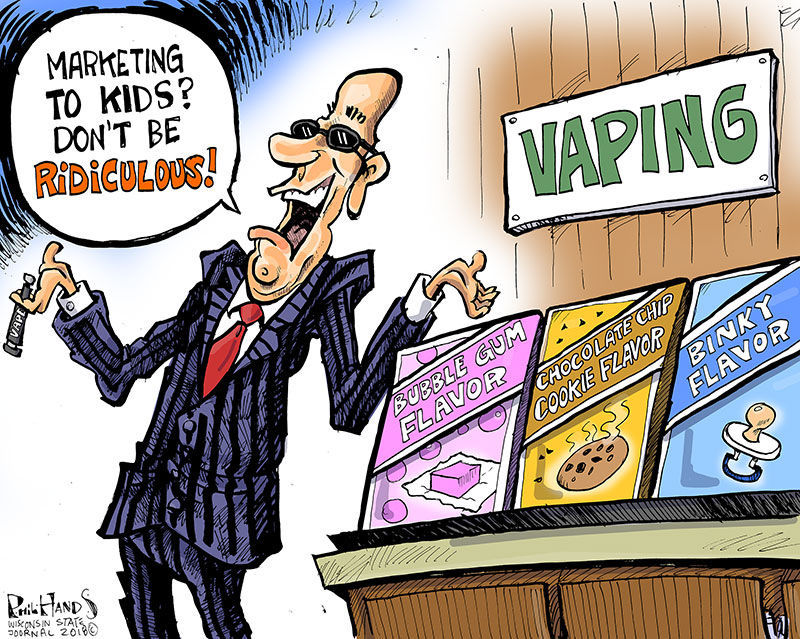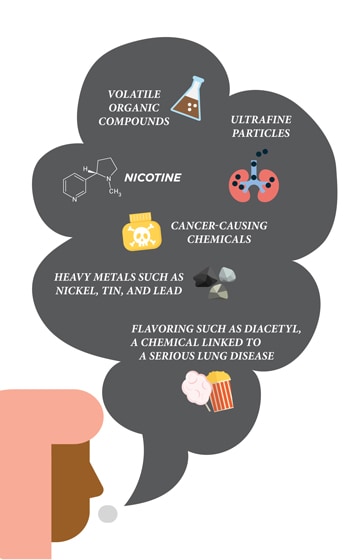JUUL is not COOL
Current news cycles have been dominated by a “new” scientific controversy, JUUL e-cigarettes. JUUL is a proprietary vaping system that serves as an alternative to tobacco filled cigarettes. The founders of JUUL, Adam Bowen and James Monsees, are former smokers themselves, so the small, slim JUUL pod is a replacement for people that already smoke. This allows smokers to satisfy their nicotine “craving” by vaping. Nicotine is a highly addictive chemical that is a prime ingredient of cigarettes and e-cigarettes alike. Researchers are increasingly raising public awareness regarding the harmful health effects of nicotine, causing a moral, political, and economic crisis. Large manufacturers of nicotine products such as JUUL are the center of the public outrage as it is claimed that the company targets teenagers; teens are the leading consumers of the highly addictive JUUL products. Instead of marketing JUUL products to adults, the public accused the company of getting teens “hooked” with nicotine-based products. The common public is divided into two groups, some encourage the sale of JUUL products, while others strongly oppose the company and its policies. Those in support have an economic agenda and those against argue the issue’s moral and political aspects.
Background Information
E-cigarettes were promoted as a healthier alternative to potentially more harmful tobacco products, but that is no longer the case. Recently, several users of JUUL, including teens, have died and hundreds more hospitalized due to lung infections. The public was quick to put the blame on JUUL, but the “FDA’s background document explains: ‘We do not currently have sufficient data about these products to determine [the] effects e-cigarettes have on the public health’,” (Sarewitz). Health professionals are hesitant to hold JUUL accountable as many of those hospitalized also smoked marijuana. The marijuana controversy overlaps with JUUL; therefore, e-cigarettes cannot be singled out. Still, JUUL is under the public spotlight since, “unlike many other e-cigarettes, JUUL devices use nicotine salts derived from tobacco leaves, enabling [the] delivery of nicotine at levels comparable to cigarettes,” (Koval, et al, 2018). This controversy encouraged numerous discussions regarding cigarettes in general, yet many are still insistent that JUUL is a healthier alternative considering nicotine is not cancerogenic. Nevertheless, “leaked documents appearing in the late spring indicated that the World Health Organization (WHO) was preparing to take an uncompromising stance against e-cigarettes…treating them as a threat equal to tobacco cigarettes,” (Fairchild & Bayer, 2015).
For (in Favor)
The goal of large e-cigarette corporations is to generate as much profit as possible, hence they are supportive of JUUL products. The national outcry over JUUL has negatively impacted the company’s economic standing. Altria Group, the largest tobacco company in the world, bought thirty-five percent of JUUL; an investment of 12.8 Billion dollars quickly depreciated to 4.5 Billion. The rejection of this product has left JUUL no choice but to react in favor of those against nicotine-based products. “The e-cigarette maker announced this month that it would suspend online sales of most flavored products in anticipation of a ban by the Trump administration,” (Robertson). Altria is the maker of Marlboro, however cigarette sales decreased which led them to invest in JUUL, as the demand in the e-cigarette market was increasing. “At the time, Altria, hurting from a decline in smoking, saw JUUL as a way to shift its business away from traditional cigarettes,” (Robertson).
Moreover, individuals in favor of JUUL also argue that e-cigarettes minimize health risks compared to traditional cigarettes. To distinguish the risk between traditional and electronic cigarettes, clear definitions of smoking and vaping must be made. “If all US smokers ‘vaped’ (the verb coined to distinguish inhaling e-cigarette [vapors] from inhaling tobacco smoke) instead of smoked, about 480,000 deaths might eventually be avoided per year,” (Sarewitz 2014). Smoking is a term associated with traditional cigarettes. Vaping on the other hand, “allows you to be addicted to nicotine (which is not carcinogenic), and to enjoy the tactile pleasures of smoking without exposing yourself to the 60 or more cancer-causing agents, or most of the hundreds of other toxic chemicals, that are released from burning tobacco,” (Sarewitz 2014). A strong economic bias leads companies to support JUUL products and the reduced health risk of e-cigarettes generates support from consumers as well. There are hundreds of ingredients present in traditional cigarettes, causing thousands of chemical reactions when burned, so most smokers will vape to avoid chemicals known to cause cancer. Nicotine is highly addictive, and some need an alternative to fulfill the addiction without major health repercussions. “Some advocates argue that elimination of a habit like smoking should always be the goal; others maintain that risk minimization is sufficient,” (Fairchild & Bayer, 2015).
Against (Not in Favor)

On the contrary, numerous people condemn JUUL for fostering an epidemic that has drastically shifted the spectrum of e-cigarettes. This paradigm shift is based upon moral and political beliefs. The moral issue underlying the distribution of JUUL is that big corporations target young adults as the audience of their advertisements, getting them “hooked” at an early age. JUUL’s advertising implicitly appealed to teens, under the age of eighteen, via social media and other communication networks that have integrated into popular culture. “While the campaign wasn’t targeted specifically at teenagers, a former senior manager said that he and others in the company were well aware it could appeal to them,” (Richtel & Kaplan). Young adults are trying to conform to an ever-changing society and new trends quickly gain attraction. The general argument in this scenario is that “positive trends suggest that the powerful appeal of tobacco and nicotine has been reduced in younger generations…[yet] high-tech e-cigarettes [are] capable of delivering nicotine at levels comparable to cigarettes, [having] the potential to undo years of progress if a new generation of young people becomes addicted to nicotine,” (Koval, et al, 2018). Parents are urging the FDA to regulate the distribution of these products and remove advertisements that appeal to the younger demographic. “The nicotine inhaled while vaping is less a concern for adults than these toxins, but it remains a serious health issue for teenagers, whose brains are still developing,” (Richtel & Kaplan). E-cigarettes enable teens to purchase them online where it is extremely difficult to verify age. The variety of JUUL flavors is considered colorful, youthful, and teen-friendly, allowing teens to be easy targets of social media commercials. During the developmental stages of a young adult’s life, nicotine can become a need which is incurable. Adults are moving down the chain from smoking to vaping, while teens can use JUUL as a gateway drug propelling them in the reverse and potentially more harmful direction.

Additionally, the largest moral argument against JUUL is the hundreds of teens and adults that have been hospitalized due to “vaping lung” or “wet lung.” “The [CDC] and local health departments have been scrambling for weeks now to find the cause of a strange uptick in severe pulmonary illnesses linked to vaping, which resembles the ‘popcorn lung’ seen by people who inhale chemicals all day for work,” (Feltman). Previously, many smokers switched to vaping to avoid dangerous chemicals but that is no longer the case. JUUL has never tested for inhalation safety, causing greater dismay among the public and a call for increased FDA regulations. The variety of flavors appeals to the youth and the number of “vaping lung” cases is on the rise; this trend is not a coincidence. The reason for which JUUL pods and flavors are sold is that “the United States…requires products [to] be proven ‘safe and effective’—not in absolute terms, as in the case of harm and reduction…before being allowed onto the market,” (Fairchild & Bayer, 2015). JUUL reduces harm so it is deemed “safe and effective,” hence the selling of this product is completely legitimate and legal. Nonetheless, “for now, any e-cigarette or vaping product is considered potentially dangerous and the CDC urges people to refrain,” (Feltman). JUUL is under fire for its products’ safety and its role in the surge of teen users. Parents do not see the difference between smoking and vaping when their children are victims of brutal respiratory diseases. The use of e-cigarettes is considered “cool” however, every individual must be aware of the possible benefits and risks of using them.

Conclusion
Every controversy has a political agenda and policymakers are pleading to the World Health Organization. “They argued, to remain open to evidence regarding ‘low-risk noncombustible nicotine or tobacco products that may become viable alternatives to smoking in the future’ as a potential harm-reduction strategy,” (Fairchild & Bayer, 2015). Most of the population does not recognize JUUL as a viable alternative, yet it is believed, by some, that future implications of this product are more beneficial than the current risks. Political and health organizations such as the CDC and FDA believe there is not enough research around the health crisis of JUUL. It is safe to say that vaping is less harmful than smoking for adults, but parents ignore this distinction because smoking and vaping are the same for teens that have clearly shown tremendous interest in JUUL products. At this point, the FDA motioned that their “nicotine-focused strategy [is] reducing the major adverse health effects from cigarette smoking,” (Koval, et al, 2018). The current political goal is to reduce the consumption of nicotine among adults, but the public outrage pushed political organizations to forbid the sale of any nicotine products to the youth, teens, and young adults. One must understand that potential benefits and risks of JUUL products exist, forming a rift between the two clashing sides of the controversy.
References
Fairchild, A., & Bayer, R. (2015). Public health. Smoke and fire over e-cigarettes. Science (New York, N.Y.), 347(6220), 375-376.
Feltman, R. (2019, September 26). There are now 805 cases of ‘vaping lung’ and at least a dozen deaths. Retrieved November 03, 2019, from https://www.popsci.com/cdc-vape-lung-805-cases/.
Koval, R., Willett, J., & Briggs, J. (2018). Potential Benefits and Risks of High-Nicotine E-Cigarettes. JAMA, 320(14), 1429-1430.
Richtel, M., & Kaplan, S. (2018, August 27). Did Juul Lure Teenagers and Get ‘Customers for Life’? Retrieved from https://www.nytimes.com/2018/08/27/science/juul-vaping-teen-marketing.html.
Robertson, K. (2019, October 31). Juul’s Meltdown Costs Tobacco Giant Altria $4.5 Billion. Retrieved November 03, 2019, from https://www.nytimes.com/2019/10/31/business/altria-juul.html?searchResultPosition=1.
Sarewitz, D. (2014). Allow the use of electronic cigarettes to assess risk: Monitoring the outcomes of incentivized e-cigarette use, not endless research, will be the key to sensible regulation. Nature, 512(7512), 349.
Scientific Controversy Paper Reflection



